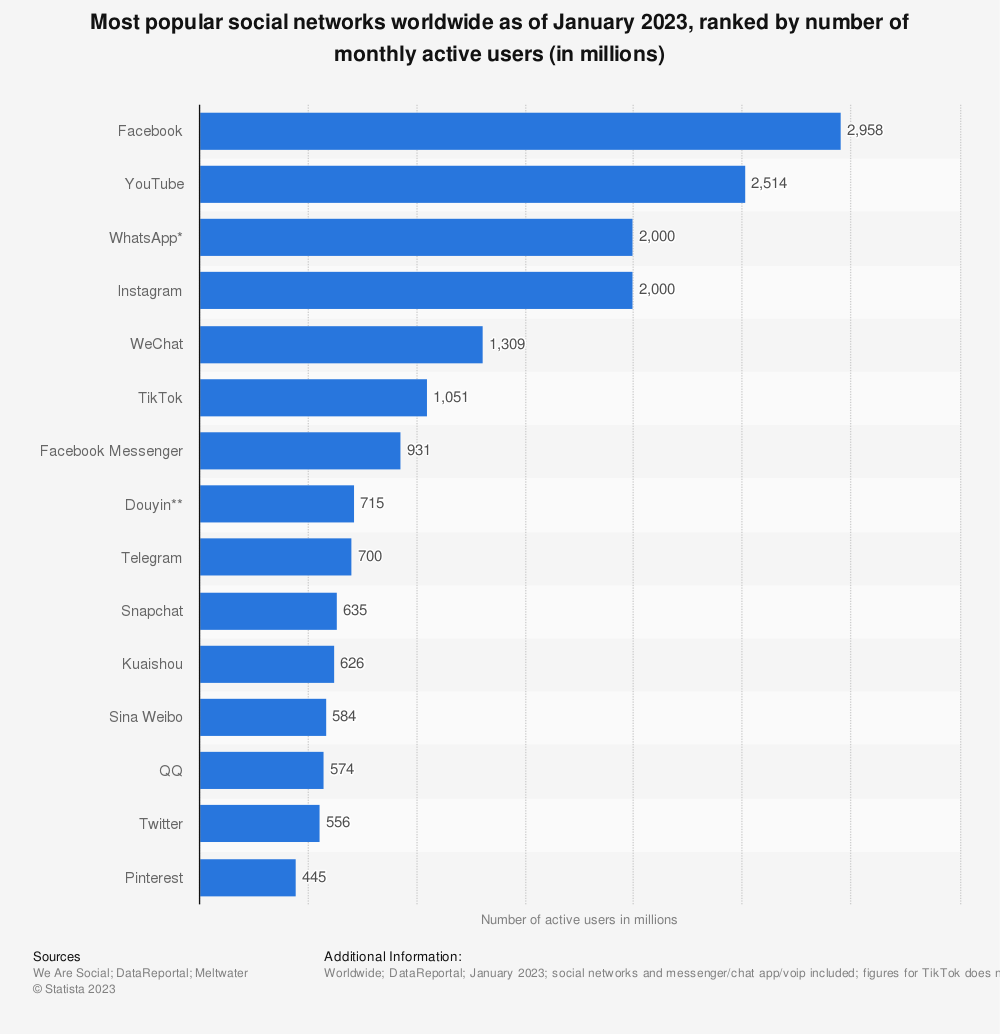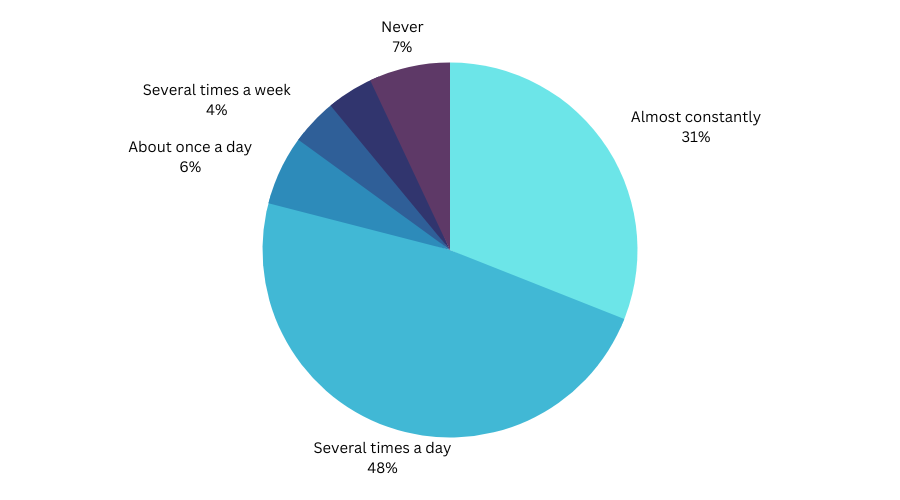Screen Time: Worrisome Statistics & Facts [Longterm Data]
Kids aged 8 to 10 spend a whopping 8 hours a day glued to screens!
10 min. read
Updated on
Read our disclosure page to find out how can you help Windows Report sustain the editorial team Read more
Key notes
- South Africa has the highest desktop screen time, with an average of 4 hours & 25 minutes per day.
- For more such enthralling reveals, keep reading this post!

Whether you are a teen or a septuagenarian, we all enjoy spending time in front of screens. Mobile phones, tablets, laptops, TVs, and computers are the most popular screens.
With the advancement of technology, it has become essential to explore the ever-evolving digital landscape and the alarming rates of screen usage.
This comprehensive guide will shed light on screen time statistics over the years with long-time insights, facts, and data supporting how it has affected our lives.
According to the American Academy of Pediatrics, a child between 2 and 5 should only be allowed to use the screen for 1 hour per weekday & 3 hours per weekend.
The younger kids should not have screen time at all. The school children’s daily screen time limit should be only 2 hours for non-school work.
According to a study by the National Heart, Lung, and Blood Institute, adults should limit their screen time to two hours or less per day outside work.
Screen Time Statistics (2013-2022)
Global Average Hours of Screen Time per Day
In 2022, the average time spent on screen worldwide is 6 hours 37 minutes, and since 2013, the daily screen time has increased by 28 minutes per day.
This is a report issued by GlobalWebIndex (GWI) indicating the rise and fall of screen time from 2013 to 2022:
| Year | Time ( HH: MM) | Relative Y-o-Y change (%) |
| 2013 | 06:09 | – |
| 2014 | 06:23 | 3.8 |
| 2015 | 06:20 | -0.8 |
| 2016 | 06:29 | 2.4 |
| 2017 | 06:46 | 4.4 |
| 2018 | 06:48 | 0.5 |
| 2019 | 06:38 | -2.5 |
| 2020 | 06:55 | 4.3 |
| 2021 | 06:57 | 0.5 |
| 2022 | 06:37 | -4.8 |
With the COVID-19 pandemic, the world was in lockdown, and there was a striking surge in device usage and daily screen time globally.
It increased to 6 hours and 55 minutes in 2020, rose to 6 hours and 57 minutes in 2021, but decreased to 6 hours and 37 minutes in 2022 as everything started to normalize, a minute less than the time in 2019.
Another alarming impact of the lockdown was a 52% increase in average screen time consumption among kids, primarily due to online classes and their home confinement.
A study by JAMA Pediatrics shows that pre-pandemic, screen time, including televisions, computers, and smartphones, was an average of 162 minutes per day, which jumped to 246 minutes during the pandemic (more than 4 hours).
Mobile Device Usage Statistics
According to the Jan 2023 DataReportal report, the average mobile screen time of a user worldwide based on all activities is 5 hours per day.
If this average is to hold true, then we collectively spend 10 trillion hours on our mobile devices every year, which equates to 1.1 billion years of entire human existence.
The Indonesians spend 5 hours and 39 mins, the highest, and Chinese people spend 3 hours and 33 minutes, the lowest of all countries. Here is the complete data:
| Country | Time spent (HH: MM) |
| Indonesia | 05:39 |
| Brazil | 05:19 |
| Saudi Arabia | 05:18 |
| Singapore | 05:18 |
| Average | 05:01 |
| South Korea | 04:59 |
| Mexico | 04:56 |
| Australia | 04:54 |
| India | 04:51 |
| Japan | 04:48 |
| Thailand | 04:40 |
| Canada | 04:38 |
| U.S.A | 04:21 |
| Turkey | 04:18 |
| U.K. | 04:14 |
| France | 03:52 |
| Argentina | 03:51 |
| Germany | 03:36 |
| China | 03:33 |
An average user spends 30% of their waking lives using their smartphones.
According to Statcounter, in 2013, only 14.35% of the total web visits were by mobile, and it has surged to 55.45% as of August 2023, which is truly remarkable.
A survey conducted by Deloitte in 2022 says an average person in America checks their phone 47 times a day.
Social Media App Usage Statistics
According to Statista, in January 2023, Facebook, with 2958 million monthly active users, remains on the top of the chart, followed by YouTube with 2514 million and WhatsApp with 2000 million.
Here are the most popular social networks globally ranked by active users per month:

Users in the US spend 55.8 minutes on TikTok in 2023, making it the most-used app in the region. Here are the details for all popularly used apps:
With this, in January 2023, according to DataReportal, TikTok is also the most used social media app globally, with 23.5 hours of time spent per month. Here are the details:
| Social media app | Time spent in hours/month |
| TikTok | 23.5 |
| YouTube | 23.1 |
| 19.7 | |
| WhatsApp Messenger | 17.3 |
| 12.0 | |
| Line | 11.0 |
| 5.5 | |
| Telegram | 4.0 |
| Snapchat | 3.2 |
| Facebook Messenger | 3.1 |
The highest social media usage was recorded in the Philippines at 4 hours and 12 mins, followed by Brazil at 3 hours and 39 mins, Columbia at 3 hours and 34 mins, and Nigeria at 3 hours and 26 mins. Here are the top 15 countries with social media usage in hours:
| Country | Time spent (HH: MM) |
| Philipines | 04:12 |
| Brazil | 03:34 |
| Columbia | 03:31 |
| Indonesia | 03:26 |
| Argentina | 03:18 |
| Nigeria | 03:17 |
| Mexico | 03:12 |
| Thailand | 03:11 |
| Ghana | 03:07 |
| Egypt | 03:04 |
| Malaysia | 03:04 |
| UAE | 03:01 |
| Kenya | 02:59 |
| South Africa | 02:59 |
| Turkey | 02:53 |
In 2013, digital users were spending an average of 1 hour and 37 minutes per day on social media, and it increased to 2 hours and 31 mins in 2022.
Video Game Usage Statistics
As per the Global Overview Report by DataReportal, the percentage of people playing games worldwide is 81.9%. Here is the list of countries with the same data:
| Country | Percentage of people playing video games |
| Philippines | 95.8% |
| Indonesia | 94.8% |
| Vietnam | 93.1% |
| Thailand | 93% |
| Turkey | 92.3% |
| India | 91.9% |
| Mexico | 91.3% |
| Taiwan | 91.3% |
| Saudi Arabia | 90.1% |
| South Africa | 89.7% |
| Brazil | 88.4% |
| U.A.E | 88.2% |
| Chile | 87.6% |
| Malaysia | 87.4% |
| Greece | 86.3% |
| Colombia | 84.8% |
| Portugal | 84.7% |
| Egypt | 83.4% |
| Romania | 83.3% |
| Hong Kong | 83.1% |
| U.S.A | 82.9% |
| Singapore | 81.7% |
| Poland | 80.9% |
| France | 80.8% |
| Italy | 80.6% |
| Argentina | 80.2% |
| Spain | 79.8% |
| Canada | 79.5% |
| Russia | 79.5% |
| Sweden | 78.4% |
| Israel | 78.3% |
| South Korea | 77.9% |
| Switzerland | 77.6% |
| New Zealand | 75.9% |
| Czechia | 75.5% |
| Austria | 75.2% |
| Netherlands | 75% |
| Australia | 74.6% |
| Germany | 74.3% |
| Denmark | 72.7% |
| U.K. | 72.4% |
| China | 72.1% |
| Ireland | 72.1% |
| Belgium | 69.5% |
| Japan | 66.4% |
Don’t you think every country on the list should take a preventive measure, given the long-term adverse effects?
If we talk about the age distribution of individuals playing video games on any device, 89.7% of males and 87.3% of females between the age of 16-24 are leading the statistics. Here is the complete data as of January 2023:

US vs. The Rest of the World Screen Time Statistics
In 2022, upon segregating the daily screen time for users aged 16 to 64 on any device across different countries, it was found that South Africa had the highest screen time, i.e, 10 hours 46 mins, while Japan had the lowest, with 4 hours 26 mins, and the U.S.A with 7 hours 5 mins.
However, the latest report from GWI in January 2023 indicates that the numbers are going down, suggesting that the pandemic impact is slowly wearing off.
The updated average screen time by country statistics shows the United States at 6 hours 59 mins, South Africa still leading with 9 hours and 38 minutes, Japan still maintaining its position at 3 hours and 45 minutes, while the global average time spent is 6 hours and 37 minutes, which is 21 minutes less than in 2022. Here is the latest data for all countries:
| Country | Time spent (HH: MM) (2022) | Time spent (HH: MM)(2023) |
| South Africa | 10:46 | 09:38 |
| Brazil | 10:19 | 09:32 |
| Philippines | 10:27 | 09:14 |
| Argentina | 09:38 | 09:01 |
| Colombia | 10:03 | 09:01 |
| Mexico | 08:55 | 08:07 |
| Malaysia | 09:10 | 08:06 |
| Thailand | 09:06 | 08:06 |
| Russia | 07:50 | 07:57 |
| Indonesia | 08:36 | 07:42 |
| Egypt | 08:02 | 07:41 |
| Portugal | 07:56 | 07:37 |
| U.A.E. | 08:36 | 07:29 |
| Turkey | 08:00 | 07:24 |
| Saudi Arabia | 08:05 | 07:20 |
| Taiwan | 08:07 | 07:14 |
| Israel | 07:35 | 07:08 |
| Romania | 07:09 | 07:03 |
| U.S.A. | 07:05 | 06:59 |
| Singapore | 07:29 | 06:59 |
| Poland | 06:39 | 06:42 |
| Canada | 06:45 | 06:35 |
| Hong Kong | 06:46 | 06:26 |
| India | 07:19 | 06:23 |
| Vietnam | 06:38 | 06:23 |
| New Zealand | 06:23 | 06:12 |
| Sweden | 06:22 | 06:02 |
| Greece | 06:06 | 06:00 |
| Ireland | 06:30 | 05:59 |
| Italy | 06:09 | 05:55 |
| Australia | 06:13 | 05:51 |
| U.K. | 06:12 | 05:47 |
| Spain | 06.04 | 05:45 |
| Switzerland | 05:44 | 05:38 |
| Belgium | 05:45 | 05:27 |
| Netherlands | 05:11 | 05:27 |
| France | 05:34 | 05:26 |
| China | 05:12 | 05:25 |
| Austria | 05:42 | 05:22 |
| South Korea | 05:29 | 05:21 |
| Germany | 05:22 | 05:12 |
| Denmark | 05:02 | 04:58 |
| Japan | 04:26 | 03:45 |
The average time spent has decreased for most of the countries except China (5:25) and the Netherlands (05:27).
On an average, Americans check their smartphones every 4 minutes.
With a whopping 44.39% daily screen time, Indians use social media the most, followed by Indonesians, i.e, 42.86%, while the average screen time worldwide is 38.04%
And, with an average of 2 hours and 16 minutes, Americans use 32.46% of their screen time with social media, followed by the British, whose 1 hour and 56 minutes are taken up using social media platforms.
A US teenager spends 7 hour 30 minutes in front of a screen every day.
Based on Pew Research conducted from Jan 2021 to Feb 2021, this study also indicates that 31% of Americans are always online, and 48% go online several times a day. Here is the data:

Digital Device Usage by Age Group (Children)
According to a Children and Parents: Media Use and Attitudes 2023 report by Ofcom, mobile phones (69%) and tablets (64%) were the most used devices to go online among kids aged between 3-17 years.
Approixmately 49% of 0 to 2-year-olds engage with smartphones
68 percent of children between the age of 7-18 own or have access to different devices, including mobile phones, tablets, gaming consoles, and handheld players. Here is the detailed data
| Devices | Access | Own |
| Tablet | 74% | 59% |
| Laptop or Notebook | 67% | 43% |
| Games console/player | 77% | 68% |
| Smart speaker | 56% | 35% |
| Desktop | 51% | 23% |
The majority of children aged 3-17 (85%) watched programs or movies using a TV set, but a substantial portion (80%) also accessed the content via other devices, including 50% of them using tablets and 46% a mobile phone. Here are the details:
| Device | Percentage used to watch TV or films |
| Television set | 85% |
| Tablet | 50% |
| Mobile | 46% |
| Games Console | 26% |
| Computer | 23% |
US teen (13-18) spends an average of more than 8 hours per day on screen for entertainment; tweens (8-12) are reported to be looking at the screen for approximately 5 hours daily, apart from their school work.
Despite YouTube claims that it is intended for aged 13 or older, 76% of 8 to 12 years old watch videos on the site, the rest mentioned using the YouTube Kids app.
As the device most used by kids, we have divided them into five groups 3-4-year-olds, 5-7-year-olds, 8-11-year-olds, 12-15-year-olds, and 16-17-year-olds. Here are the details:
| Age group | Most used device | Going online | Playing games | Watching TV |
| 3-4-year | Tablets | 75% | 50% | 67% |
| 5-7 year | Tablets | 86% | 67% | 67% |
| 8-11 year | Tablets | 70% | 69% used consoles instead | 55% |
| 12-15 year | Mobile phone | 96% | 68% | 63% |
| 16-17 year | Mobile phone | 97% | 67% used consoles instead | 67% |
Kids spending more time on screens can be perturbing for their parents; therefore, monitoring their activities can help them control screen time and ensure a healthier balance in their daily lives.
Increase in Mobile Phone, Tablet, and PC Use During the Pandemic
According to GWI report 2022, the pandemic profoundly impacted global television habits, and popular online streaming platforms like Netflix and Disney+ took up to 45% of the total TV viewing time of working-age internet users.
However, traditional television (cable channels and broadcast) still occupies the other half.
According to DataReportal Global Overview report in January 2023, 56.9% of daily time spent on the Internet by users aged 16 to 64 globally is via mobile while 43.1% is on computers.
Research by the National Library of Medicine indicates that Americans in their early twenties spent an average of 28.5 hours per week on their smartphones in 2020, 2.6 hours more than in 2018.
A broad survey by GWI in 2021 indicates that despite the decline in ownership of laptops and desktop, it is still used the most to go online; here is the data to specify the time spent on devices over the years:
| Devices Used | 2021 | 2022 | 2023 |
| Mobile Phone (Any) | 97.1% | 96.6% | 92.3% |
| Smartphone | 96.6% | 96.2% | 91.0% |
| Laptop/Desktop | 64.4% | 63.1% | 65.6% |
| Connected Television | 14.4% | 15.5% | 31.9% |
| Smart Watch or Smart Wristband | 23.3% | 27.4% | 28.6% |
| Tablet device | 34.3% | 34.8% | 27.3% |
| Smart Home device | 12.3% | 14.1% | 15.4% |
| Games console | 21.4% | 20.8% | 12.7% |
| Feature phone | 9.0% | 8.8% | 5.2% |
Negative Effects of Too Much Screen Time
The latest screen time statistics show that the amount of time spent in front of a screen decreases to an extent as the world adjusts to the new normal.
However, the numbers are still concerning, as excessive screen time could have harmful effects, especially if it becomes a habit. Some of the adverse effects are:
- Poor posture and eye strain.
- Increases the risk of cyber threats.
- It might disrupt your sleep as the blue light may interfere with melatonin production, making it difficult to slow.
- Symptoms of anxiety, depression, or feeling lonely.
- May reduce face-to-face conversation, affecting interpersonal & social skills.
- Replaces the physical activities, leading to a sedentary lifestyle.
Decreasing screen time is important for our mind and body’s health and development. If you can’t control your screen time, use an app to help you remind you or switch from normal mode to focus on your device to avoid distractions.
You can also check the latest technology addiction statistics so that you know how important it is to use devices responsibly.
In case you are interested in more such statistics, like how many computers are in the world, check out this guide.
If you have any questions about the data presented or want more information about screen time statistics, please mention them in the comments section below.










